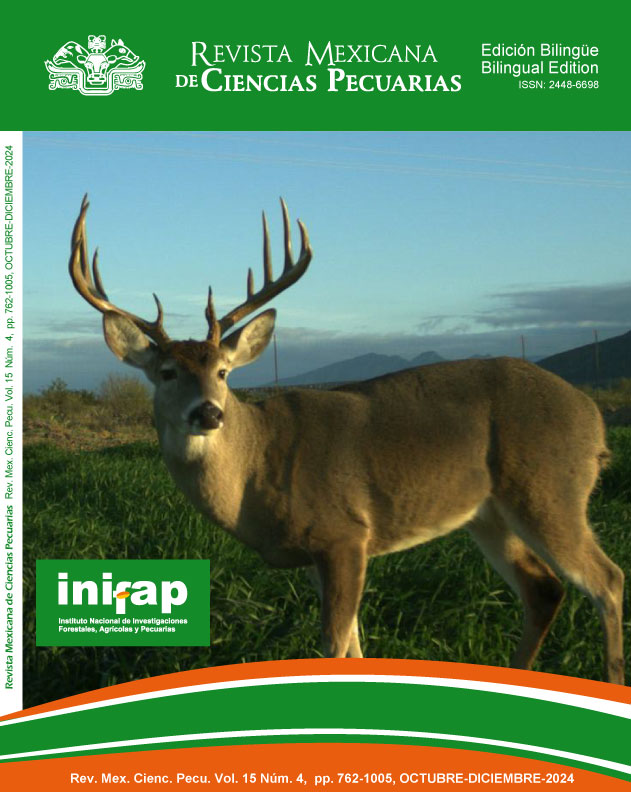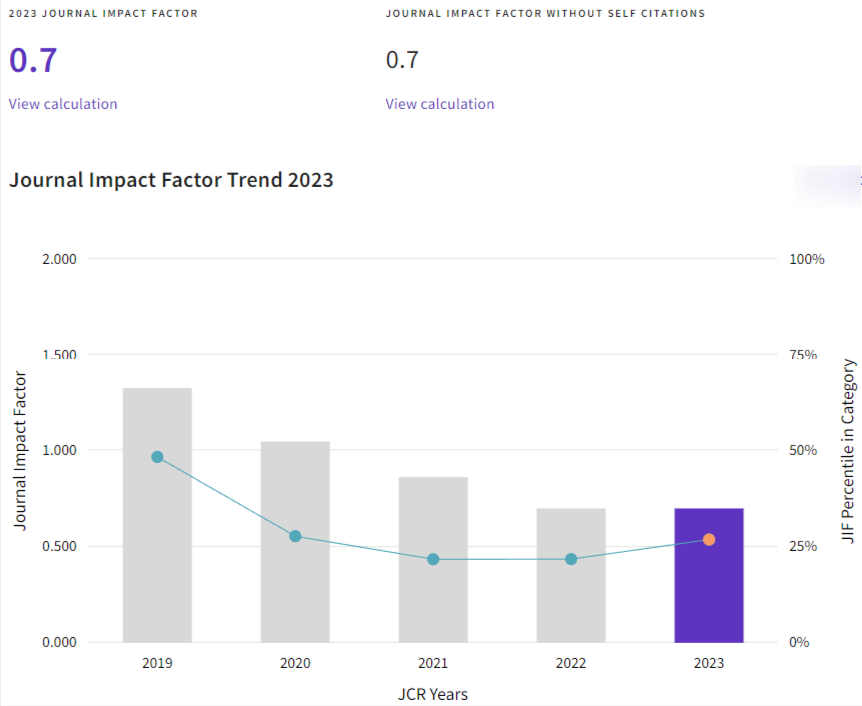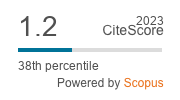Evaluación antihelmíntica in vitro de curcumina contra huevos y larvas de aislados de Haemonchus contortus con distinta susceptibilidad a ivermectina
DOI:
https://doi.org/10.22319/rmcp.v15i4.6440Palabras clave:
polifenol, antihelmíntico, desenvaine larvario, estabilizadores poliméricosResumen
El creciente problema de resistencia a los antihelmínticos (AHs) convencionales en poblaciones de nematodos gastrointestinales (NGI), ha motivado la búsqueda de alternativas para su control en los rebaños de ovinos y caprinos, como es el caso de los metabolitos secundarios de plantas. En el presente trabajo se evaluó la actividad AH in vitro de curcumina (CUR) contra tres aislados del nematodo de rumiantes Haemonchus contortus con diferente susceptibilidad a los AHs convencionales. Se utilizaron las pruebas in vitro de inhibición de la eclosión de huevos (IEH), inhibición de la migración larvaria (IML), inhibición del desenvaine larvario (IDL) y mortalidad a las 72 h de L3 sin vaina. Las pruebas se realizaron usando un intervalo de concentraciones de 0 - 8.5 μg CUR/ml. Solamente la prueba de IDL fue realizada con un intervalo de concentración de 0 - 17.3 μg CUR/ml. Se obtuvieron las curvas de concentración-respuesta en una regresión log-logística y se realizó un diseño completamente al azar mediante un ANOVA. La CUR no presentó actividad AH en las pruebas de IEH, IML y mortalidad, pero sí demostró efecto AH significativo en la prueba de IDL. Este efecto fue más potente contra el aislado FMVZ-UADY (CE50= 1.9 μg/ml, IC95% 1.58-2.31), seguido por el aislado Paraíso (CE50= 3.2 μg/ml, IC95% 2.69-3.81) y CENID-SAI, INIFAP (CE50= 7.0 μg/ml; IC95% 6.58-7.43). Se concluye que la CUR tiene efecto AH contra el desenvaine de las L3 de H. contortus pero no afecta la eclosión de huevos, la migración de L3 o la mortalidad de L3 sin vaina a las dosis evaluadas.
Descargas
Citas
Encalada-Mena LA, Corbala-Bermejo JA, Vargas-Magaña JJ, García-Ramírez MJ, Uicab-Brito L, del Río-Rodríguez J. Gastrointestinal nematode prevalence in dual purpose systems in the municipality of Escárcega, Campeche, México. Agrociencia 2009;43(6):569–576.
Rinaldi L, Catelan D, Musella V, Cecconi L, Hertzberg H, Torgerson PR. et al. Haemonchus contortus: spatial risk distribution for infection in sheep in Europe. Geospat Health 2015;19:325–331.
Coop RL, Holmes PH. Nutrition and parasite interaction. Int J Parasitol 1996;26(8-9):951-962.
Arsenopoulos KV, Fthenakis GC, Katsarou EI, Papadopoulos E. Haemonchosis: A Challenging parasitic infection of sheep and goats. Animals 2021;11:1–28.
Besier RB, Kahn LP, Sargison ND, Van Wyk JA. The Pathophysiology, Ecology and Epidemiology of Haemonchus contortus Infection in Small Ruminants. Adv Parasitol 2016;93:95-143.
Rose H, Rinaldi L, Bosco A, Mavrot F, De Waal T, Skuce P. et al. Widespread anthelmintic resistance in European farmed ruminants: a systematic review. Vet Rec 2015;176(21):546-546.
Torres-Acosta JFJ, Hoste H, Sandoval-Castro CA, Torres-Fajardo RA, Ventura-Cordero J, González-Pech P. et al. The art of war against gastrointestinal nematodes in sheep and goat herds of the tropics. Rev Académica Cienc Anim 2019;17:39-46.
Mancilla-Montelongo G, Castañeda-Ramírez GS, Torres-Acosta JFJ, Sandoval-Castro CA, Borges-Argáez R. Evaluation of cinnamic acid and six analogues against eggs and larvae of Haemonchus contortus. Vet Parasitol 2019;270:25-30.
Lima CS, Pereira MH, Gainza YA, Hoste H, Regasini LO, de Souza Chagas AC. Anthelmintic effect of Pterogyne nitens (Fabaceae) on eggs and larvae of Haemonchus contortus: Analyses of structure-activity relationships based on phenolic compounds. Ind Crops Prod 2021;164:113348.
Nelson KM, Dahlin JL, Bisson J, Graham J, Pauli GF, Walters MA. The essential medicinal chemistry of curcumin. J Med Chem 2017;60(5):1620–1637.
Tsuda T. Curcumin as a functional food-derived factor: degradation products, metabolites, bioactivity, and future perspectives. Food Funct 2018;9(2):705-714.
Mimche PN, Taramelli D, Vivas L. The plant-based immunomodulator curcumin as a potential candidate for the development of an adjunctive therapy for cerebral malaria. Malar J 2011;10(Suppl 1):1-9.
Rauf A, Imran M, Orhan IE, Bawazeer S. Health perspectives of a bioactive compound curcumin: A review. Trends Food Sci Technol 2018;74:33–45.
Trujillo J, Chirino YI, Molina-Jijón E, Andérica-Romero AC, Tapia E, Pedraza-Chaverrí J. Renoprotective effect of the antioxidant curcumin: Recent findings. Redox Biol 2013;1(1):448–456.
Xue X, Yu JL, Sun DQ, Zou W, Kong F, Wu J. et al. Curcumin as a multidrug resistance modulator - A quick review. Biomed Prev Nutr 2013;3(2):173–176.
Mahmood K, Zia KM, Zuber M, Salman M, Anjum MN. Recent developments in curcumin and curcumin based polymeric materials for biomedical applications: A review. Int J Biol Macromol 2015;81:877–890.
De Aguiar DP, Moscardini MBM, Morais ER, De Paula RG, Ferreira PM, Afonso A. et al. Curcumin generates oxidative stress and induces apoptosis in adult Schistosoma mansoni worms. PLoS One 2016;11(11):1–25.
Cervantes-Valencia ME, Alcalá-Canto Y, Sumano-Lopez H, Ducoing-Watty AM, Gutierrez-Olvera L. Effects of Curcuma longa dietary inclusion against Eimeria spp. in naturally-infected lambs. Small Ruminant Res 2016;136:27-35.
Singh A, Varshneya C, Telang RS. In vitro anthelmintic effect of Curcuma longa. Indian Vet J 2005;82(6):594–596.
Ullah S, Khan MN, Sajid MS, Muhammad G. Comparative anthelmintic efficacy of Curcuma longa, Citrullus colocynthis and Peganum Harmala. Glob Vet 2013;11(5):560–567.
Nasai NB, Abba Y, Abdullah FFJ, Marimuthu M, Tijjani A, Sadiq MA. et al. In vitro larvicidal effects of ethanolic extract of Curcuma longa Linn on Haemonchus larval stage. Vet World 2016;9(4):417–420.
Yallapu MM, Jaggi M, Chauhan SC. Curcumin nanoformulations: a future nanomedicine for cancer. Drug Discov 2012;17(1-2):71-80.
Rafiee Z, Nejatian M, Daeihamed M, Jafari SM. Application of curcumin-loaded nanocarriers for food, drug and cosmetic purposes. Trends Food Sci Technol 2019;88:445-458.
Paradkar A, Ambike AA, Jadhav BK, Mahadik KR. Characterization of curcumin–PVP solid dispersion obtained by spray drying. Int J Pharm 2004;271(1-2):281-286.
Hernandez-Patlan D, Solis-Cruz B, Pontin KP, Latorre JD, Baxter MF, Hernandez-Velasco X. et al. Evaluation of a solid dispersion of curcumin with polyvinylpyrrolidone and boric acid against Salmonella enteritidis infection and intestinal permeability in broiler chickens: A pilot study. Front Microbiol 2018;9:1–10.
Teodorescu M, Bercea M. Poly(vinylpyrrolidone) – A versatile polymer for biomedical and beyond medical applications. Poly Plast Technol Eng 2015;54(9):923–943.
Sadeghi F, Ashofteh M, Homayouni A, Abbaspour M, Nokhodchi A, Garekani HA. Antisolvent precipitation technique: A very promising approach to crystallize curcumin in presence of polyvinyl pyrrolidon for solubility and dissolution enhancement. Colloids Surf B 2016;147:258-264.
Guo L, Shi M, Song N, Wan Z, Liu H, Liu L. Anchorage of curcumin onto PVP enhances anti-tumor effect of curcumin. Med Chem Res 2019;28(5):646–656.
Sepúlveda-Vázquez J, Lara-Del Rio MJ, Vargas-Magaña JJ, Quintal-Franco JA, Alcaraz-Romero RA, Ojeda-Chi MM. et al. Frequency of sheep farms with anthelmintic resistant gastrointestinal nematodes in the Mexican Yucatán peninsula. Vet Parasitol: Reg Stud Rep 2021;24:1–7.
Mancilla-Montelongo MG, González-Pech PG, Miranda-Miranda DY, Castañeda-Ramírez GS, Encalada-Aguilar PA, Can Celis AC. et al. Targeted treatment strategies for the control of gastrointestinal nematodes in a goat flock with anthelmintic resistant worm populations and poor nutrition. Small Rumin Res 2023;227:107062.
Von Samson-Himmelstjerna G, Coles GC, Jackson F, Bauer C, Borgsteede F, Cirak VY. et al. Standardization of the egg hatch test for the detection of benzimidazole resistance in parasitic nematodes. Parasitol Res 2009;105(3):825–834.
Demeler J, Küttler U, von Samson-Himmelstjerna G. Adaptation and evaluation of three different in vitro tests for the detection of resistance to anthelmintics in gastro intestinal nematodes of cattle. Vet Parasitol 2010;170:61–70.
Encalada-Mena LA, López-Arellano, R, López-Arellano ME, Mancilla-Montelongo M G, Sandoval-Castro CA, Olmedo-Juárez A. et al. Curcumin-PVP improves the in vitro efficacy of ivermectin against resistant and susceptible Haemonchus contortus. Exp Parasitol 2024;256:108670.
Reyes-Guerrero DE, Cedillo-Borda M, Alonso-Morales RA, Alonso-Díaz MA, Olmedo-Juárez A, Mendoza-de-Gives P. et al. Comparative study of transcription profiles of the P-glycoprotein transporters of two Haemonchus contortus isolates: Susceptible and resistant to ivermectin. Mol Biochem Parasitol 2020;238:111281.
Ramos-Bruno E, Sandoval-Castro CA, Torres-Acosta JFJ, Sarmiento-Franco LA, Torres-Fajardo R, Chan-Pérez, JI. et al. Nitrogen retention in hair sheep lambs with a gradient of Haemonchus contortus infection. Vet Parasitol 2021;296:109488.
Mendoza de Gives P, Torres-Acosta JF, Figueroa-Castillo JA, Soberanes-Céspedes N, Mancilla-Montelongo MG, Jasso-Villazul C. et al. Diagnóstico y control sustentable de nematodos gastrointestinales en ovinos y caprinos en la era de la resistencia antihelmíntica. Primera ed. Mérida, Yucatán, México: Editorial Universidad Autónoma de Yucatán; 2023.
Bauer BU, Pomroy WE, Gueydon J, Gannac S, Scott I, Pfister K. Comparison of the FLOTAC technique with the McMaster method and the Baermann technique to determine counts of Dictyocaulus eckerti L1 and strongylid eggs in faeces of red deer (Cervus elaphus). Parasitol Res 2010;107:555-560.
Ministry of Agriculture, Fisheries and Food (MAFF). Manual of veterinary parasitological laboratory techniques. 3rd ed. London. Her Majesty´s Stationery Office (HMSO); 1986.
van Wyk JA, Mayhew E. Morphological identification of parasitic nematode infective larvae of small ruminants and cattle: A practical lab guide. Onderstepoort J Vet Res 2013;80(1):1–14.
Liu W, Zhai Y, Heng X, Che FY, Chen W, Sun D. et al. Oral bioavailability of curcumin: problems and advancements. J Drug Target 2016;24(8):694–702.
Buchi (2021) Application note No. 747/2021. Determination of curcuminoids in turmeric powder. https://assets.buchi.com/image/upload/v1623829658/pdf/ShortNotes/SN_747_2021_Determination_of_Curcuminoids_in_turmeric_powder.pdf.
Food Safety and Standards Authority of India (FSSAI). Manual of methods of analysis of foods: spices, herbs and condiments. New Delhi, Government of India, Ministry of Health and Family Welfare; 2012.
Coles GC, Jackson F, Pomroy WE, Prichard RK, Von Samson-Himmelstjerna G, Silvestre A. et al. The detection of anthelmintic resistance in nematodes of veterinary importance. Vet Parasitol 2006;136(3–4):167–185.
Jackson F, Hoste H. In vitro methods for primary screening of plant products for direct activity against ruminant nematodes. In: Vercoe PE, et al editors. In vitro screening of plant resources for extra- nutritional attributes in ruminants: Nuclear and related methodologies. Springer;2010:25–45.
Liébano-Hernández E, López-Arellano ME, Vázquez-Prats V, Mendoza de Gives P. Cryopreservation of infective larvae of Haemonchus contortus. Rev Latinoam Microbiol 1996;38(2):111-114.
Ritz C, Baty F, Streibig JC, Gerhard D. Dose-response analysis using R. PLoS One 2015;10(12):1–13.
R Core Team. A language and environment for statistical computing Vienna, Austria. 2020.
Ripley B, Venables B, Bates DM, Hornik K, Gebhardt A. Firth D, Ripley MB. Package ‘mass’. Cran R 538. 2013;113-120.
Calabrese EJ. Hormesis: path and progression to significance. Int J Mol Sci 2018;19(10):2871.
Calabrese EJ, Mattson MP. How does hormesis impact biology, toxicology, and medicine?. NPJ Aging Mech 2017;3(1):13.
Moghaddam NSA, Oskouie MN, Butler AE, Petit PX, Barreto GE, Sahebkar A. Hormetic effects of curcumin: What is the evidence? J Cell Physiol 2019;234(7):10060–10071.
Rainey NE, Moustapha A. Petit PX. Curcumin, a multifaceted hormetic agent, mediates an intricate crosstalk between mitochondrial turnover, autophagy, and apoptosis. Oxid Med Cell Longev 2020;3656419.
Cruz-Aguila J. Pruebas in vitro de extractos vegetales contra Haemonchus contortus [tesis licenciatura]. México, Tabasco: Universidad Autónoma Chapingo; 2018.
Kiuchi F, Goto Y, Sugimoto N, Tsuda Y, Akao N, Kondo K. Nematocidal activity of turmeric: synergistic action of curcuminoids. Chem Pharm Bull 1993;41(9):1640–1643.
Olmedo-Juárez A, Rojo-Rubio R, Arece-García J, Salem AZ, Kholif AE, Morales-Almaraz E. In vitro activity of Pithecellobium dulce and Lysiloma acapulcensis on exogenous development stages of sheep gastrointestinal strongyles. Ital J Anim Sci 2014;13(4):3104.
Li B, Konecke S, Wegiel LA, Taylor LS, Edgar KJ. Both solubility and chemical stability of curcumin are enhanced by solid dispersion in cellulose derivative matrices. Carbohydr Polym 2013;98(1):1108-1116.
Rathnayaka RMMP, Madhusankha GDMP, Perera ODAN. Curcumin ethanolic extraction and its’ stability in food applications. In 2019 From Innovation to Impact (FITI), 1-6.
Marin-Tun CG, Mancilla-Montelongo MG, Capetillo-Leal CM, Sandoval-Castro CA, Hoste H, Borges-Argáez R, Torres-Acosta JFJ. Adapting the in vitro rumen incubation method to evaluate the effect of a plant extract on the exsheathment inhibition of Haemonchus contortus infective larvae. Vet Parasitol 2024;327:110135.
Sommerville RI. The exsheathing mechanism of nematode infective larvae. Exp Parasitol 1957;6(1):18-30.
Spiegler V, Liebau E, Hensel A. Medicinal plant extracts and plant-derived polyphenols with anthelmintic activity against intestinal nematodes. Nat Prod Rep 2017;34(6):627-643.
Hardman WE. Diet components can suppress inflammation and reduce cancer risk. Nutr Res Pract 2014;8(3):233-240.
Ali R, Rooman M, Mussarat S, Norin S, Ali S, Adnan M, Khan SN. A systematic review on comparative analysis, toxicology, and pharmacology of medicinal plants against Haemonchus contortus. Front Pharmacol 2021;12:644027.
Palevich N, Maclean PH, Subbaraj AK, Cao M. A multimodal metabolomics approach to elucidate the trigger components of rumen fluid for larval exsheathment in a model gastrointestinal parasitic nematode, Haemonchus contortus. bioRxiv 2021. [preprint]
Chan-Pérez JI, Torres-Acosta JF, Sandoval-Castro CA, Hoste H, Castañeda-Ramírez GS, Vilarem G. et al. In vitro susceptibility of ten Haemonchus contortus isolates from different geographical origins towards acetone:water extracts of two tannin rich plants. Vet Parasitol 2016;217:53–60.
Chan-Pérez, JI, Torres-Acosta JFJ, Sandoval- Castro CA, Castañeda-Ramírez GS, Vilarem G, Mathieu C. et al. Susceptibility of ten Haemonchus contortus isolates from different geographical origins towards acetone:water extracts of polyphenol-rich plants. Part 2: Infective L3 larvae. Vet Parasitol 2017;240:11-16.
Descargas
Publicado
Cómo citar
-
Resumen210
-
PDF104
-
PDF 21
-
Texto completo23
-
Full text 16
Número
Sección
Licencia

Esta obra está bajo una licencia internacional Creative Commons Atribución-NoComercial-CompartirIgual 4.0.
Los autores/as que publiquen en la Revista Mexicana de Ciencias Pecuarias aceptan las siguientes condiciones:
De acuerdo con la legislación de derechos de autor, la Revista Mexicana de Ciencias Pecuarias reconoce y respeta el derecho moral de los autores/as, así como la titularidad del derecho patrimonial, el cual será cedido a la revista para su difusión en acceso abierto.

Esta obra está bajo una Licencia Creative Commons Atribución-NoComercial-CompartirIgual 4.0 Internacional.





